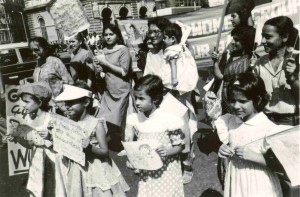NGO-isation has engulfed all of civil society organsing in India, including the women’s movement. While it has strengthened many groups’ institutional position and enabled a wider outreach, feminist solidarity and feminist ideology seem to have taken a back seat
By Vibhuti Patel
NGO-isation clearly represents the growing dominance of a certain organisational form that is different from the early consciousness-raising organisations and also different from the mass organising that women have been very good at. NGO-isation is not particular to women though. The impact of NGO-isation varies depending on the resources, level of operation and the organisational motives behind adopting the NGO model.
Historical Backdrop
When social movements of 1970s and 1980s started fragmenting and losing their mass base due to issue based narrow struggles, formation of special interest groups and cooption of articulate, urbane, English knowing, professionally qualified activists and leaders of peoples’ movement: peasant movement, workers’ movement, Dalit movement, youth movement, women’s movement and tribal movement into power structures, NGO-isation process began. Initially, they were called non-party political formations or voluntary organisations. In course of time they developed into legalised entities as registered societies, public trusts, non-profit or pro-profit trusts supported by local, corporate, state or foreign funding institutions.
There was an understanding that in the non- government organisations level of motivation was high, they were non-corrupt and were free from nepotism and red-tapism. During 1980s and 1990s, the NGOs were applauded by UN bodies as rooted in ‘the local reality’, ‘full of idealism’ and ‘bottom up’ and ‘participatory’ in their approach. Many liberal and socialist thinkers also declared them as third force for social transformation, first two being Government bodies and political parties.
Beyond Guilt-Tripping
New awareness among the funding institutions about mis-utilisation of funding by government agencies was as a result of intense debate on corruption, leakage and misappropriation of funding in the Asian, Latin American and African countries during 1950-1980. In the early 1990s, there was a fear that the global funding might get diverted to East European countries that was culturally closer to the western world and had faced massive economic and political crisis due to collapse of Soviet Union.
This debate in the development studies circle brought massive changes in the functioning of the social movements in the post colonial countries which were subsidised by the outside funding. Initially, activists and experts from the minority communities and women were forced to accept foreign funding as they were marginalised in their own countries. Rest of the social movements derived benefits of these funding without publicly acknowledging the source.
Structural Adjustment Programme and stabilisation policies resulted into massive reduction in the state funding. Even the mainstream institutions and organisations started turning to foreign funding. New dialogue with the funders based on mutual respect has helped to get rid of the anxiety that the developing world would be left out by the aid agencies. Induction of highly qualified professionals from developing countries as consultants to screen the proposals for funding is supposed to have reduced wastage and vested interest.
NGO-isation impacts on smaller women’s organisations operating at the local level in terms of an expansion of structure, loss of autonomy, erosion of agenda setting power and a prioritisation of accountability towards donors. However, some national-level women’s organisations have been able to manage the process through strategically mobilising resources and prioritising own agendas, thus retaining their feminist character.
At a wider level, the NGO-isation process has led to a blurring of the boundaries between the gender and development agenda and feminist discourses. This blurring of boundaries created opportunities for raising women’s rights issues at different levels, but led perhaps to a generational shift in how younger women engage with gender equity issues.
NGO-isation has impacted structure, agenda, autonomy, agency and accountability of different types of women’s/feminist organisations. Adoption of service-delivery models promoted by the NGOs and concerns over losing the feminist political agenda has taken away steam from the women’s liberation movement. Influence of management institutions have changed vocabulary of women’s NGOs who talk in terms of SWOT, OD, skill Development, value for money, value addition, USP, beneficiary and benefactor.
Feminist solidarity and feminist ideology have taken a back seat as in a neoliberal backdrop each one is competing for patronage, travel grant and institutional funding and perpetually insecure about poaching of talented staff and diversion of funding. ‘Contact is capital’, ‘Network for Power’ and ‘Concentration and Centralisation of Resources’ have been the mantra of NGO-isation. In this culture; spontaneity, trust, solidarity, collective efforts have been replaced by calculated moves, secrecy, individualism and atomized existence among women’s groups.
The only positive fall out of NGO-isation process is that, the feminist organisations have been able to strengthen their institutional positions (recognition by the mainstream bodies, consultancy, training centres, building, staff, and financial security) and create a wider reach through the links they have developed through collaboration on NGO projects. Moreover, women’s organizations were forced to rethink their mobilisation strategies and discourses, as a larger number of educationally qualified younger women and men engage with the gender and development projects implemented by NGOs.
Vibhuti Patel is active in the women’s movement in India since 1972 and currently teaching at SNDT women’s University, Mumbai.

I totally agree with you on many points you raised Vibhuti. However we do need to look at questions like how would the Indian women’s movement had shaped if there had not been many NGOs in the picture. You say it has helped women’s groups in having greater reach. How do we know what would have been the reach of the movement minus the NGO’s and the 10 to 5 activism they have introduced? Maybe the movement would have been more vibrant, more effective, more revolutionary, more political and more human.